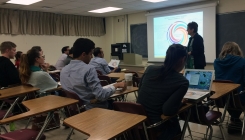On the heels of LGBTQ History Month in October, UMBC held a lecture called “Queering Experience: Applying Intercultural Praxis to LGBTQ Issues.”
For anyone that was not deep into the academia behind that strong statement, it could have seemed intimidating. However, lecturer Kathryn Sorrells, the department chair of communication studies at California State University, Northridge, broke it down quite easily.
A classroom on the first floor of the Janet and Walter Sondheim Hall was the setting as Sorrells started with a short introduction about herself, her background and how she identified. As she discussed this, she told a little story about she came about her current label.
“One of the women in my family has a daughter who keeps asking me if I am a boy or a girl and I started to say ‘I am a girl with a little bit of boy,’ and without missing a beat she responded with, ‘I’m a girl with a whole lotta girl.’”
Following this interesting categorization technique and keeping with the night’s theme, Sorrells posed some “queertions” to consider. Among these were what is/are you gender(s), how do you know, what is/are your race(s), how do you know and what is/are your sexuality/sexualities and how do you know?
Attendees quietly scribbled down their answers before Sorrells delved into what it means to be queer and the cultural and political meaning of the term. The definition of the word being “strange, odd, unusual,” and its first real emergence in colloquialism dating back to the ‘60s where it would be used to describe an object or circumstance, not a person.
From there, the focus was shifted to queering as a verb, which meant “to make strange what is taken as normal,” and with that came reclaiming the word queer. After this, Sorrells attempted to reinterpret what it means to be queer through the lens of sexuality and gender.
One overarching theme that was mentioned was mobility and boundary crossing, which communicated geographic and cultural spaces with respect to gendered, racial, heteronormative/queer and religious influences.
Sorrells supplemented this by talking about her times living in Japan and Turkey, and how the national ideals played a role in gender and sexuality there.
The talk of global differences and similarities flowed into definitions of culture: as a shared community and as a contested meaning to name a few. Commodification and empowerment were two topics that fell under discussing culture as a resource, which brought about the discussion of hierarchical and power differences in many different arenas.
The lecture ended with a revisit to the questions Sorrells had asked at the beginning of the presentation and the floor was opened to the audience. A brief yet stimulating conversation about the true meaning of gender and sex, and the difference between the two, took place.
“You do what society expects you to do,” said Sorrells.





